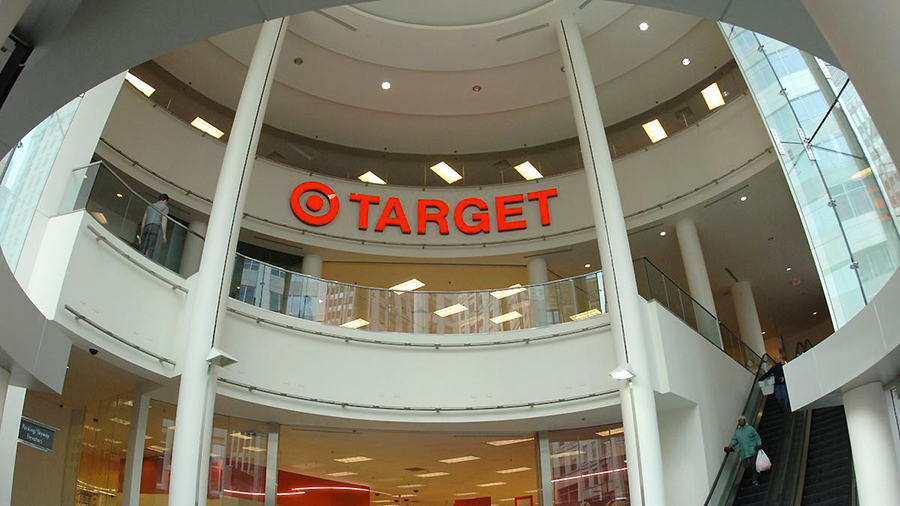Target, Inc. reduced its full-year profit outlook on “continued near-term challenges on the topline” The readjustment came despite the discounter reporting second-quarter earnings that handily topped Wall Street as tight inventory controls offset lower-than-expected sales.
Second quarter GAAP and Adjusted EPS1 of $1.80 was more than 4 times higher than a year ago and above the high end of the company’s guidance range between $1.30 to $1.70, reflecting a meaningful profit recovery from last year’s inventory actions. Wall Street’s consensus estimate had been $1.48.
The company’s second-quarter operating income margin rate of 4.8 percent was more than 3 percentage points higher than last year, driven by a higher gross margin rate.
Second quarter comparable sales declined 5.4 percent, below plan. The discounter had said that based on softening sales trends in the first quarter, it was planning for a wide range of sales outcomes in the second quarter, centered around a low-single-digit decline in comparable sales.
Total revenue of $24.8 billion was below analysts’ consensus estimate of $25.6 billion.
Inventory at the end of Q2 was 17 percent lower than last year, reflecting a 25 percent reduction in discretionary categories, partially offset by inventory investments to support frequency categories, and strategic investments to support long-term market-share opportunities.
Given recent sales trends, the company lowered its full-year sales and profit expectations. The company now expects comparable sales in a wide range around a mid-single-digit decline for the remainder of the year, and now expects full-year GAAP and Adjusted EPS of $7.00 to $8.00.
Under its previous guidance, Target expected comparable sales in a wide range from a low-single-digit decline to a low-single-digit increase, operating income growth of more than $1 billion, and both GAAP EPS and Adjusted EPS of $7.75 to $8.75.
For the third quarter, the company expects comparable sales in a wide range around a mid-single-digit decline, and GAAP and Adjusted EPS of $1.20 to $1.60. In the year-ago quarter, EPS was $1.54.
Brian Cornell, chair and chief executive of Target Corporation, said, “Our second quarter financial results clearly demonstrate the agility of our team and the resilience of our business model, as we saw better-than-expected profitability in the face of softer-than-expected sales. With the benefit of a much-leaner inventory position than a year ago, the team was able to quickly respond to rapidly-changing topline trends throughout the second quarter, while continuing to focus on the guest experience.”
“As we move into the Fall, the team is gearing up for the biggest seasons of the year, with a focus on continuing to serve our guests with newness throughout our assortment. At the same time, we continue to take a cautious approach to planning our business and have therefore adjusted our financial guidance in anticipation of continued near-term challenges on the top line. This approach, along with the long-term investments we’re making in our business and strategy, positions us to deliver sustainable, profitable growth in the years ahead.”
Guidance
Given recent sales trends, Target now expects comparable sales in a wide range around a mid-single-digit decline for the remainder of the year. The company now expects full-year GAAP and Adjusted EPS of $7.00 to $8.00, compared with the prior range of $7.75 to $8.75.
Operating Results
Comparable sales declined 5.4 percent in the second quarter, reflecting comparable store sales declines of 4.3 percent and comparable digital sales declines of 10.5 percent. Total revenue of $24.8 billion was 4.9 percent lower than last year, reflecting a total sales decline of 4.9 percent partially offset by a 1.3 percent increase in other revenue. Second quarter operating income of $1.2 billion was 273.0 percent higher than last year, driven by a higher gross margin rate.
Second quarter operating income margin rate was 4.8 percent in 2023, compared with 1.2 percent in 2022. Second quarter gross margin rate was 27.0 percent, compared with 21.5 percent in 2022, reflecting lower markdowns and other inventory-related costs, lower freight costs, retail price increases, and lower supply chain and digital fulfillment costs. These benefits were partially offset by higher inventory shrink. Second quarter SG&A expense rate was 20.9 percent in 2023, compared with 19.2 percent in 2022, reflecting the de-leveraging impact of lower sales combined with higher costs, including continued investments in pay and benefits and inflationary pressures throughout our business, partially offset by disciplined cost management.
Interest Expenses and Taxes
The company’s second-quarter 2023 net interest expense was $141 million, compared with $112 million last year, reflecting higher average long-term debt balances combined with the impact of higher floating interest rates.
Second quarter 2023 effective income tax rate was 22.2 percent, compared with the prior year’s rate of 15.8 percent. The rate increase was driven by higher earnings, which diluted the benefit of fixed and discrete tax items.
Capital Deployment and Return on Invested Capital
The company paid dividends of $499 million in the second quarter, compared with $417 million last year, primarily driven by a 20.0 percent increase in the dividend per share.
The company did not repurchase any stock in the second quarter. As of the end of the quarter, the company had approximately $9.7 billion of remaining capacity under the repurchase program approved by Target’s Board of Directors in August 2021.
For the trailing twelve months through the second quarter of 2023, after-tax return on invested capital (ROIC) was 13.7 percent, compared with 18.4 percent for the trailing twelve months through the second quarter of 2022. The decrease in ROIC was driven primarily by lower profitability coupled with an increase in invested capital. The tables in this release provide additional information about the company’s ROIC calculation.
Photo courtesy Target
















